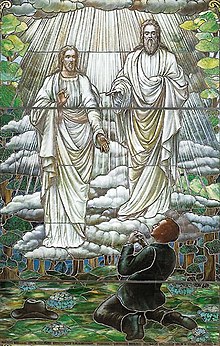First vision

The first vision is an important part of Mormon belief . The version, later included in the official history of the Church in the book Pearl of Great Price , describes how the later 14-year-old founder of The Church of Jesus Christ of Latter-day Saints Joseph Smith in a forest near his home in Palmyra , New York in 1820 two persons, God and Jesus Christ , appeared.
Smith puts the vision in the context of his search for the true religion and claims to have received the message that all existing denominations have falsified the gospel of Christ. He should not join any religious community.
The interpretations of the First Vision differ among the various currents within the Mormon movement. The central assumption is that the first vision was the beginning of the Church of Jesus Christ LDS because it called upon Smith to seek the true faith and, with the help of further revelation, to restore the lost dogmas of early Christianity . This would end the “great apostasy ”.
Former Church President Gordon B. Hinckley said:
“Our cause, the cause of the members of The Church of Jesus Christ of Latter-day Saints, rests on whether this glorious First Vision has actually taken place. This opened the veil for this, the dispensation of the fulness of times. Nothing we base our teaching on, nothing we teach, nothing we live by is more important than this first proclamation. I assert that if Joseph Smith spoke to God the Father and to His Beloved Son, then everything else he spoke of is also true. This is the hinge on which the door hangs that leads to the path of salvation and eternal life. "
Versions of the First Vision
The official version in the history of the church comes from 1838. It refers to the year 1820 and speaks of a new faith with missionaries of all denominations, which made the young Joseph aware of the diversity of religions. Smith goes on to say that he was criticized and persecuted for his decision not to join a church and had another vision three years later. It would have announced the discovery of gold plates with written revelations engraved on them.
This version has been criticized because a religious departure for the region is proven from earlier years and the year 1824, but not for 1820. Furthermore, contrary to his testimony, the rejection of all churches cannot have had any particular influence on Smith's family, as his mother and others Relatives were still active Presbyterians many years later and there is evidence that he himself took part in a course of the Presbyterian Church for several years after the official date of the First Vision.
Other versions, some of which differ considerably, have survived from the years 1827 and 1830, although they were only published much later as memorial reports by family members and early chroniclers of Smith. The first version from Smith's own hand dates back to 1832 and was not published until 1965: Here the vision took place in 1821 (Smith was already 15), he had been reading the Bible for years and was for himself I concluded that all denominations had deviated from true Christianity. Only Jesus Christ appeared to him here and forgave his sins . There is no question of a revelation about the truth of the denominations. The second vision with the announcement of the golden plates took place two years later.
In 1859, a companion who was temporarily close to Smith reported his memories in an interview. According to this, the vision would not have taken place until 1827 (Smith was already 21 years old) and it would have been in connection with the treasure hunt that would have led Smith to the gold plates. This version is almost entirely consistent with the earliest reports listed above.
Web links
- Church of Jesus Christ of Latter-day Saints: Accounts of the First Vision
- Mormon Wiki: The First Vision of the Prophet Joseph Smith
- Encyclopedia of Mormonism : The First Vision
- The First Vision - viewed critically
Individual evidence
- ↑ Andreas Grünschloss: The "other Bible" - suppressed, secret and new revelations. In: Reinhard Feldmeier , Hermann Spieckermann (Ed.): The Bible. Origin - message - effect. Vandenhoeck & Ruprecht, Göttingen 2004, ISBN 3-525-53626-7 , pp. 148–170, here p. 159 f.
- Jump up ↑ Joseph Smith, History of the Church. Chapter 1, verse 19 .
- ↑ What do people ask about us?
- ↑ Wesley P. Walters: New Light on Joseph Smith's First Vision , 2005. Located on the Institute of Religious Research - Project Mormons in Transition website
- ^ First Vision versions follow: Institute of Religious Research - Project Mormons in Transition: Joseph Smith's Changing First Vision Accounts
- ^ Institute of Religious Research - Project Mormons in Transition: 1832 First Vision Account with digitization and transcription of this version
- ^ Institute of Religious Research - Project Mormons in Transition: 1859 First Vision Account by Martin Harris
